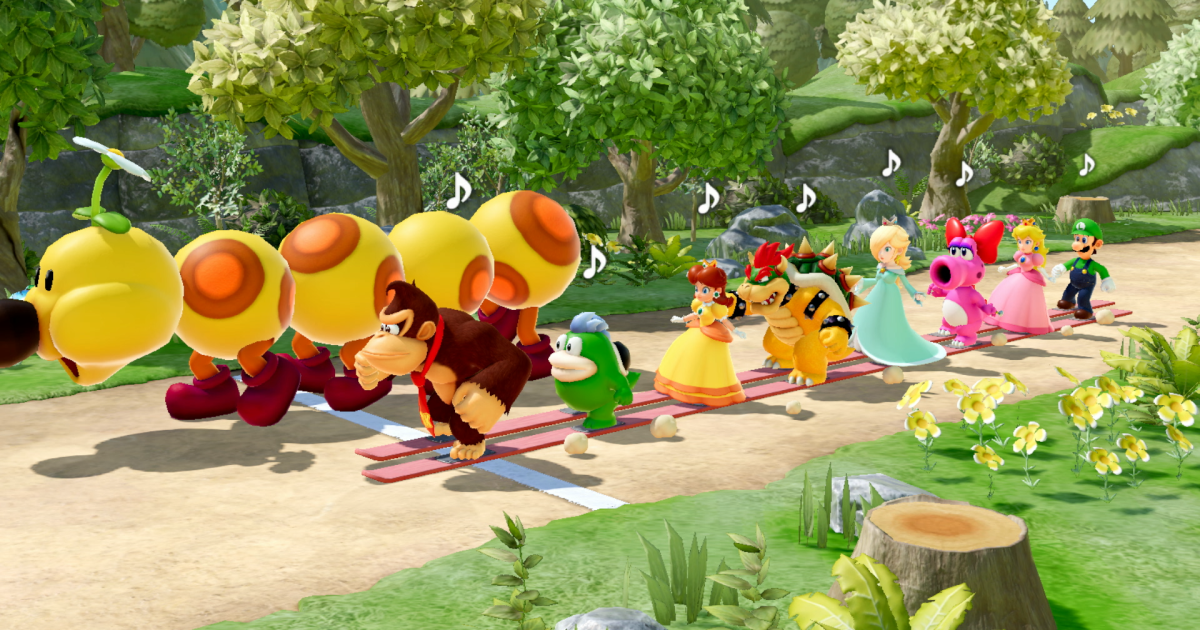Super Mario Party Jamboree
MSRP $60.00

“Super Mario Party Jamboree gives partygoers a lot more bang for their buck.”
Pros
- Great new boards
- More strategic board game play
- Welcome single-player modes
- Creative minigames in side modes
Cons
- Core board minigames are dull
- Inconsistent motion controls
- Some dud motion modes
Is it possible to keep a party going forever? For the third time in the Nintendo Switch’s lifespan, Nintendo is once again faced with that question. Super Mario Party Jamboree closes out the console’s unofficial multiplayer trilogy, which brought the series back to basics after a string of failed formula shake-ups. Since 2018’s Super Mario Party, Nintendo has taken the series back to familiar territory, focusing on the core board game at the heart of the series.
That’s been an understandable, and largely successful, decision. But when you attend this many parties, you need more than one trick. Nintendo seems to understand that with Super Mario Party Jamboree, likely the series’ most robust entry to date. In addition to including more boards than the last two Switch entries and the most minigames ever put into a single game, it also comes flush with bonus modes that aim to open the doors wider than ever. That’s necessary to sell a third Mario Party game on the Switch, though it pushes the series dangerously close to max capacity.
Super Mario Party Jamboree’s core board game is still as fun as ever, and made even better thanks to some clever new maps. Its signature minigames, though, are a little more inconsistent as some of Nintendo’s best ideas are almost exclusively saved for hit-and-miss side modes. It’s a multiplayer package that spreads itself thin, but there’s enough fun content here to keep the dice rolling for another turn.
Strategic boards
While there’s a mountain of new modes this time around, the core of Mario Party Jamboree is still the series’ signature board game. Nintendo keeps returning to that format for a reason: It remains fun as heck with friends. Like the last two entries, Jamboree doesn’t overburden itself with gimmicks. The goal is to move around a board, get stars, and win bite-sized minigames. If you haven’t clicked with that loop since its creation on the Nintendo 64, you still won’t be won over by the at times glacially paced rounds. That doesn’t mean that the formula hasn’t evolved, though.
Jamboree finds Mario Party at its most strategic, with way more to do during a round than simply racing to the star. That’s thanks in large part to some of its excellent new boards. There are seven in total, including two throwbacks and five original maps. The latter are some of the best in the series’ history thanks to their multifaceted designs. Take one as seemingly simple as Goomba Lagoon. At first, it looks like a straightforward beachside romp, but it’s filled with attractions and nuances. The tide changes every few turns, occasionally drowning players left standing on a sandbar. There’s a coin-fishing diversion, a treasure chest guessing minigame, zipline shortcuts, and a volcano that can spew lava on spaces. With several moving parts, it becomes a more dynamic play space full of risks and rewards.
Jamboree’s wealth of twists means that a savvy player could win with devious planning rather than lucky rolls.
The maps especially lend themselves to longer 30-turn battles where players have more space to chase their own side goals during a round. Rainbow Galleria best models that design philosophy. The stage is a three-floor mall filled with vendors. A round there becomes more about finding ways to stay flush with coins and spending them wisely at each shop to both get ahead and mess with other players. That can partially be accomplished by visiting stamp stations in one go around the board and returning as much as possible to the starting kiosk for extra coins (gathering all four stamps gives extra coins). A flash sale activates every few turns, which creates a mad dash to shops.
The end goal is still to get the most stars, but each map gives players way more space to achieve that goal in clever ways. There’s strategy in amassing a ton of coins and then targeting Boo spaces to steal stars from opponents. New trap items let players place down an item that can steal coins and stars from friends who land on them. If one player is closing in on a star, another could saddle them with low-rolling “creepy” dice to keep them from getting there, warp to their position to beat them to the punch, or move the star’s position entirely with a Chain Chomp Whistle. Ideas like this have always been part of the series, but Jamboree’s wealth of twists means that a savvy player could win with devious planning rather than lucky rolls.

The best new feature is Jamboree’s namesake buddy system. On occasion, another character appears on the board. Whoever wins this Jamboree Buddy in a long-form challenge, all cleverly themed around the character, gets a temporary bonus for a few turns. Waluigi, for instance, can steal coins from players when passing by them. Having a buddy also allows players to buy two stars instead of one, so grabbing one can really turn a game on its head if players act fast. The twist is that buddies can be easily stolen if a player passes by the one who currently has it. That adds a fun bit of hot potato to games that can make rounds even more cutthroat.
With so many little systems, Jamboree’s limited rule customization really sticks out. Aside from changing the number of turns or toggling motion minigames off, I don’t have much to tweak in standard party mode. A new Pro ruleset provides a great competitive alternative, one that features evil twists like limited item quantities at shops, but that mode is locked to 12 turns for no discernable reason. With more moving parts than ever, the core board game could really benefit from letting players create custom rules.
Minigames are a mixed bag
While the new boards and core gameplay are a peak for the series, Jamboree’s all-important minigames don’t rise to the occasion. Yes, on paper, the package features the most minigames ever in a Mario Party game (112, to be precise). That’s a deceptive stat, though. Those games are split between several different contexts and modes. There are quick item minigames, versus battles, buddy challenges, and more. Beyond that, though, external modes like Koopathon and Bowser’s Kaboom Squad have their own specific minigames that don’t appear in the board game, but still make up that final count. At times, it almost feels like there’s fewer mainline minigames than recent entries, as I tend to repeat the same few games a lot.
It doesn’t help that the games made specifically for the board game are disappointingly uninspired. There are few surprises or new ideas here. Several minigames boil down to “run away from something while dodging obstacles.” A lot of uninspired quizzes, match games, and button mashers appear here. Even the handful of motion-control games don’t do much with the concept; two even rehash Super Mario Party’s dreaded Trike Harder.
It often feels like Nintendo has hit a wall after decades of releases.
Very little reaches the heights of even recent favorites like Super Mario Party’s Slaparazzi, but a few stand out. Hot Cross Blocks has players building bridges across lava by selecting different-shaped blocks. Four options appear on the screen at once and players have to press a face button to select one. If two or more players pick the same piece, no one gets it, so there’s strategy in going to smaller pieces rather than risking it with longer shapes. Gate Key-pers is another strong logic puzzle where players take turns trying to match a set of keys to the gate that they open. The more players miss, the more information everyone has to deduce which key opens what door and escape first. There are still glimmers of creativity to be found, but it often feels like Nintendo has hit a wall after decades of releases.
I don’t think that’s exactly the case, though. While the core minigames underwhelm, the ones featured in other modes are often excellent. The buddy challenges, for instance, are all longer challenges that pay tribute to each character’s history. Donkey Kong’s is a full bongo rhythm game reminiscent of his Donkey Konga days, while Waluigi’s takes place in a pinball machine, a reference to his signature Mario Kart DS board. They’re long games that drag out rounds even more, but they’re consistently delightful.

Bowser’s Kaboom Squad, an eight-player side mode, features its own set of large-scale multiplayer challenges that rank among the best games in the package. One has seven players repairing a leaky pipe while another cleans off Chain Chomps with water. Another splits players into a three-part juice assembly line, where some players gather fruit while others squeeze it, and the rest deliver the final products. All of those games feel inspired, playing outside of the confines of the same four-player formats.
The Mario Party series is in a difficult position. When it first stagnated decades ago, Nintendo went through hoops to twist the concept on its head. Just about every experiment was met with indifference. The series wouldn’t get back on its feet until going back to basics; it’s no surprise that its best entry, Mario Party Superstars, is just a curated greatest hits collection. With Jamboree, I can feel Nintendo trying to wriggle itself out of a corner more carefully. Rather than messing with the board game format, it peppers great ideas into side modes, perhaps hoping that fans will actually ask for an eight-player co-op Mario Party themselves this time. That just leaves Jamboree in an awkward position as its brightest ideas are found outside of the board game.
Tons of modes
It’s no surprise that Nintendo is so invested in its side content given how much of it was crafted for Jamboree. This is a surprisingly robust multiplayer package that doesn’t just include online play and co-op games, but even single-player options too. It feels a bit like Nintendo learned a great lesson from Splatoon 3, a game that delivers several high-effort modes that mix up what players can do between Turf War matches. I see that same philosophy here, as each mode grants coins and achievements that feed back into the same faux “battle pass” collectible unlock system.
Some of those modes are strong new additions to the series. The biggest surprise is a full single-player story mode that takes cues from Super Smash Bros. Ultimate’s World of Light. Here, players free roam each of the five new maps, which are dotted with minigames and fetch quests. It’s not the most complex idea, but it effectively teaches players about each map’s features while touring them through every minigame. Those who’ve always wished they could play Mario Party when their friends aren’t around will be happy to have the option, I imagine.
There’s more fun than dud here …
Many modes featured here can feel like first drafts, as if Nintendo is conducting a focus group to see where fans want the series to go on its next console. Bowser’s Kaboom Squad is a neat stab at PVE, as eight players work together to beat an enormous Imposter Bowser by collecting cannonballs. There’s some surprisingly strategic co-op design here as players complete some of Jamboree’s best minigames between rounds to earn items like lightning bolts that help in the fight against Bowser. It’s a light offering, though, with only three slight variations that take place on the same small maps. I wouldn’t be surprised to see it spun off into a more fully realized project down the line.
Similarly, Koopathalon is a fun mass multiplayer concept that’s just a bit too thin to stand on its own. Here, 20 players are dropped on a board and have to complete solo coin-collecting minigames to run laps around it, with each coin earned translating to a space move. It’s a much faster-paced take on Mario Party that has me playing Mario-themed Breakout and whacking moles to rack up as many coins as possible. It can be a blast that captures the same energy as Switch mass multiplayer experiments like Super Mario Bros. 35, but it only has a handful of minigames that cycle in and out each time.
Where the package’s wheels really start spinning is in its suite of motion-controlled modes. Jamboree goes all-in on the Joy-Con for better and often worse. Rhythm Kitchen is the best implementation of it, creating a Rhythm Heaven-like side game where players swing, whisk, and push their controller on beat to create food with friends. It’s light on content, but a cute distraction. The same can’t be said for the other two modes. Toad’s Item Factory has potential as a 10-level puzzle game that has players twisting their Joy-Cons to move marbles to a pipe, but it’s hampered by inconsistent motion controls that are hard to wrangle. Paratroopa Flight School is the worst entry in the entire collection. It tasks playing with flying around a small map with their arms outstretched. It’s awkward, hard to control with accuracy, and even a little painful after a while. There are three ways to play, including a Crazy Taxi-style character transportation minigame, but none are refined or deep enough to be worth the struggle.

In trying to digest it all, I find myself a little torn by the eclectic extras. On one hand, they all feel like enjoyable, harmless bonuses. Do they all need to be fully built out when they’re meant to be quick diversions I can chip away at between parties? There’s more fun than dud here, even if I only feel like I’ll get an hour or two out of most modes. There’s another side of me, though, that wonders if all of those extras are a detriment to the core board game. Had Rhythm Kitchen been a smaller minigame, it would have been the most inventive one in the main game. The same goes for Toad’s Item Factory and Paratroopa Flight School, games that would have been more fun as 10- to 30-second snacks. Jamboree is full of great ideas, but too few of them are reserved for its bread-and-butter mode.
Super Mario Party Jamboree might look like a final victory lap for the series on Switch, but it’s more exciting as a taste of what’s to come. It lays out several blueprints outlining what Mario Party could look like in Nintendo’s next generation (hopefully minus the online stuttering), some of which show promise even in their limited forms here. I wouldn’t be opposed to seeing a mass-multiplayer version that lets Nintendo get more experimental with its minigames. The key to success will just be committing to one killer party instead of half a dozen shindigs.
Super Mario Party Jamboree was tested on Nintendo Switch OLED.
Read the full article here














